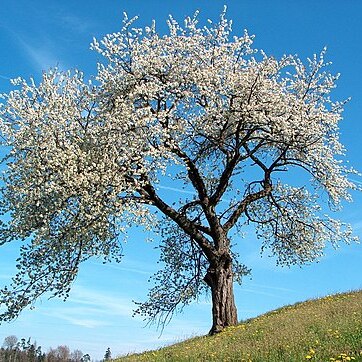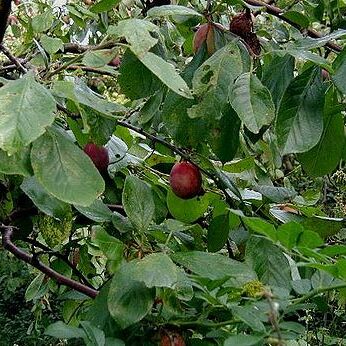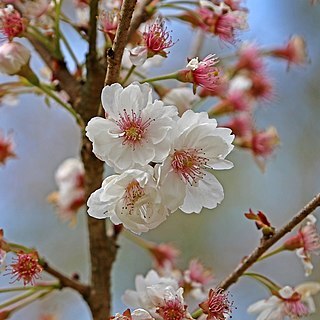Trees or shrubs, rarely with thorns. Buds protected by budscales or naked. Leaves simple, pinnately nerved, margin incised or entire, with glands in the margin and/or on the underside or on the petiole. Stipules free or (rarely) connate, on the twigs. Inflorescence basically a raceme, rarely branched, in a large part of the genus reduced to a few-flowered umbel or to only one or two flowers. Flowers normally 5-merous, usually bisexual. Sepals and petals well distinct except in sect. Mesopygeum where the perianth segments are (sub)equal or irregularly differentiated without (much) difference in size. Petals usually white or pink. Stamens many (up to 85). Pistil 1, at the bottom of the cup-, bell-or funnel-shaped hypanthium, at its base often with hairs implanted on the hypanthium, also when the ovary itself is glabrous; ovary superior, 1-locular; style terminal, stigma capitate; ovules 2, pendulous, only 1 normally developing. Fruit a drupe, mesocarp in wild species not very thick, fleshy to (rather) dry, endocarp bony to woody, thin to thick. Seed with thin testa, without endosperm.
Trees or shrubs, deciduous. Branchlets sometimes spine-tipped. Axillary winter bud solitary, ovoid; terminal winter bud absent. Stipules membranous, soon caducous. Leaves simple, alternate, convolute [or conduplicate] when young; petiolate or sessile; petiole apex or base of leaf blade margin with or without nectaries; leaf blade margin variously crenate or coarsely serrate. Inflorescences apparently axillary, solitary or to 3-flowered in a fascicle; bracts small, soon caducous. Flowers opening before or at same time as leaves. Hypanthium campanulate. Sepals 5, imbricate. Petals 5, white, sometimes purple-veined, rarely greenish, inserted on rim of hypanthium, imbricate. Stamens 20–30, in 2 whorls; filaments unequal. Carpel 1; ovary superior, 1-loculed, glabrous or sometimes villous; ovules 2, collateral, pendulous. Style terminal, elongated. Fruit a drupe, glabrous, often glaucous, usually with a longitudinal groove; mesocarp fleshy, not splitting when ripe; endocarp laterally compressed, smooth, rarely grooved or rugose.
Perennial shrubs or trees, often deciduous, sometimes evergreen, unarmed or spiny; stems erect to wide-spreading, often with well developed trunk; young shoots glabrate to tomentose. Lvs distributed along long shoots, sometimes ± in clusters, simple, entire, crenate or 1-2-serrate; stipules free, frequently deciduous. Infl. an umbel, corymb, raceme or cluster, sometimes fls solitary or paired, usually on short shoots and subtended by many imbricate bracts. Fls 5-merous, ☿, often showy, usually preceding lvs in deciduous spp. Hypanthium concave or ± campanulate to cylindric. Epicalyx 0. Sepals very variable in length, deciduous. Petals usually 5 (sometimes many in cvs), usually spreading, occasionally the lower parts appearing to form a ± campanulate tube, white or pink to red. Stamens 15-50. Ovary superior; carpel 1; style 1; ovules 2 but 1 usually aborting. Fr. a drupe with fleshy pericarp enclosing a hard, stony endocarp; seed usually 1.
Hypanthium cup-shaped, obconic, or urceolate; sep spreading or reflexed, usually soon deciduous; pet 5, white to pink or red, elliptic to obovate, spreading; stamens ca 20; pistil 1, simple, 2-ovulate, inserted at the bottom of the hypanthium and bearing a terminal style; fr a 1-seeded drupe, the exocarp fleshy or juicy, the endocarp (stone) hard; trees or shrubs with simple, serrate lvs, very often with a pair of large glands at the summit of the petiole, the fls conspicuous, umbellate or solitary from axillary buds or short lateral branches, or racemose and terminal; bark commonly with conspicuous horizontal lenticels, relatively smooth, or breaking up into smooth platelets. (Amygdalus, Cerasus, Padus) 200, mainly N. Temp.
Trees with alternate simple leaves. Flowers (in Panamanian species) white, racemose; calyx 5-lobed, the tube perigynous, cup-like, forming with the receptac-ular disk the hypanthium bearing the 15-20 stamens and 5 petals at its margin; filaments free, filiform or somewhat dilated at base; carpel 1, with terminal style and peltate or truncate stigma; ovules 2, collateral. Fruit a drupe, one-seeded, often with juicy pulp.
Flowers usually bisexual, solitary or fasciculate-corymbose or in racemes, sometimes precocious.
Leaves alternate, deciduous or persistent, simple, entire or incised; stipules small, caducous.
Carpel 1, style terminal, stigma peltate, capitate or truncate; ovules 2, collateral.
Calyx-tube obconic, campanulate, cyathiform or tubular; calyx-lobes imbricate.
Fruit drupaceous, fleshy or dry, indehiscent, 1-or rarely 2-seeded.
Perianth usually biseriate and 5-merous, sometimes irregularly so.
Stamens 10–8, inserted with the petals; filaments filiform, free.
Petals inserted at the mouth of the calyx-tube, or absent.
Trees or shrubs, sometimes spiny.



